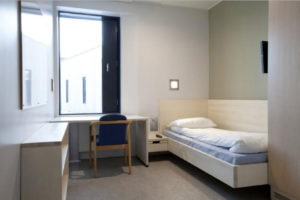
By Niclas Bez
The American Justice system has brought the most prisoners per capita in the world to the United States. Incarceration is the most common form of punishment and rehabilitation for convicted criminals. According to the U.S. Bureau of Justice Statistics in the year of 2013 there were almost 2.2 million people incarcerated in county jail, federal and state prisons. This brings the U.S. to 698 people in prison per 100,000 population.
The numbers seem even scarier when compared to history data. According to the Sentencing Project, the numbers of people being incarcerated have quadrupled since the 1980’s. The biggest part of the people are in state prisons and violent crimes are the leading cause, with robbery, sexual assault, and murder are the main crimes that people get send into prison for. Another 20 percent of all convicted crimes can be ascribed to non-violent drug conviction.
“I believe that there are alternatives to prison. How and when should we use those alternatives? For example, tax offenders might be better served if they were allowed to work and pay their tax, penalties, and fines, rather than using tax dollars to house, feed, and medicate these people,” said Criminal Justice Professor Joseph Cillo.
The extreme numbers of incarceration brings up the question about the effectiveness of the U.S. justice system. Many people wonder whether the system is the problem or if it is the people.
“As a retired police officer I’ve dealt with the U.S. Justice system and I’ve seen a lot of things that have gone wrong over the years. Anytime you have the “human factor” involved you have bias, prejudice, hate, deceit, politics and power –and all of this this seems to be influenced by the all might dollar. Basically, the U.S. justice system is directly associated with one’s ability to pay or not to pay, as the scales of justice are weighted by the amount of money placed upon them by the defense,” said Criminal Justice Professor Dr. Debra Mims.
Also, the question is brought up about the effectiveness of the rehabilitation process because the justice system seemed to be designed to help prisoners rehabilitate rather than simply to punish them, as Dr. Mims mentioned.
“Over the years the pendulum of justice seems to have swung from mandatory “three strikes” punitive approaches, to a more progressive approach of rehabilitation, and then back again. The paradigm shift seems to be in public opinion and the “get tough” on crime attitudes,” said Dr. Mims. “This shift has primarily come in the attitudes of those groups that traditionally favored rehabilitation therefore, more offenders are being incarcerated versus programs geared toward rehabilitation. Sadly, the prison system may be a necessary part of a restorative justice system.”
However, when looking at the effectiveness of prisons and the rehabilitation rate it is shocking to see. The National Institute of Justice published a study about 400,000 prisoners after their release in 2005. More than half of them (56.7 percent) were arrested before one year had passed by. Within three years of the release more than two-third (67.8 percent) of them were rearrested. After five years an incredible amount of 76.6 percent of prisoners had been rearrested. Compared to other countries that provide information about the reconviction rates the U.S. has the highest rate.
“Offenders return to prison for the same reason that they originally were placed in prison. Many repeat offenders are impacted socio-economically. Their actions are a result of their life experiences. Change what they are exposed to and I believe that crime will be impacted in a similar manner. I would change the Federal mandatory sentencing guide lines to allow Judges to use their common sense when deciding on a downward departure from those guide lines,” said Cillo, who is also a former defense attorney.
Also, when looking at European countries it shows that reinstating prisoners into society is a big challenge for justice systems in Europe as well. According to data from the U.S. National Library, the United Kingdom, Germany, and France have reconviction rates from 35 to 45 percent within three years after the prisoner’s release.
“I think that it is fair in imprisoning criminals who deserve it. However, if a prisoner is to be reinstated into society, there would have to be complete assurance that they are ready to and no longer mentally unstable, keeping people safe from them doing anything again,” said Allen Keister, who is a freshman with a major in criminal justice.
With a change of the system, society would also better accept people that have been to prison before. In fact, people are calling out the government to start working on more solutions other than incarceration that are more successful in reinstating prisoners into society after they have finished their time in prison; many former prisoners are trying to change the system to be geared towards rehabilitating.
“When I get out of prison I am in the strange position of having no money. And nothing from the state, six weeks post-release, for want of a Social Security number. And without that, no bank account, no place on the myriad databases that comprise a modern existence. I do not exist – except on the police national computer,” said John Gunn, who is a former prisoner and is now fighting for prisoners’ rights, in an interview with The Guardian.
However, there are countries like Denmark and Norway that have the lowest reconviction rates with 29 and 20 percent respectively. A research team from The Washington Post spent six weeks in Denmark visiting different prisons and found out that most of them aren’t traditional prisons. The prisoner’s live relatively independent, while cooking their own meals and making their own clothes. The inmates can leave the prison during certain times and have the right to get family visitors weekly.
According to research from the Business Insider magazine, Norway has a similar approach by trying to make it seem as normal as possible with no bars in front of the windows, sharp tools in the kitchen, and friendships between inmates and guards. Also, the cell is filled with light and looks like a friendly, small hotel room. The prisoners also learn functional jobs like woodcarving, cooking, or assembly workshops that will prepare them for a life outside of prison. With these new learned jobs, it is easier to start a real life and get back into society after they have served their prison term, as Business Insider reports.
Unfortunately, not every country is treating the prisoners with respect and dignity and have the goal to integrate these people back into society after their sentence. There is many countries, in which the living conditions are way worse than in U.S. prisons.
“When comparing the U.S. system it varies depending upon the country in which you are comparing. As we know, some countries such as Saudi Arabia, Iran and China have very strict types of punishment (public beheadings, floggings and beatings) whereas more liberal countries such as Norway or Sweden have very low recidivism rates, relying more on restorative justice and vocational programs,” said Dr. Mims.
In addition, each U.S. prison comes with a high cost. According to a research of CBS News, the cost for each prisoner per year ranges from $15,000 per year to almost $60,000 per year in states, like New York or New Jersey.
“Unfortunately, the U.S. has the highest incarceration rate in the world and many of our prisons are alarmingly overcrowded. In addition, many of the U.S. inmates that leave prison are deemed to return,” stated Dr. Mims.
In a study of the Vera Institute of Justice, the 40 surveyed states stated that their cumulative spending on prisons is $39 billion per year. And with the rising amount of prisoners, it will also become more and more expensive for the taxpayer to carry the burden. Also, the rising number of prisoners require more prisons, since the current ones are already over capacity, as Dr. Mims mentioned.
It could be eye opening for the U.S. government that they need to change something in order to get the problem under control. Major researchers from newspapers, like The Washington Post and Business Insider, have travelled to more successful prison systems and found that their way of improving the system can also work in the United States. The drastic change to get to the standard, like Norway, might not even required, but programs need to be put in place that give a prisoner a future and help them rehabilitate and learn skills for life.
A change in the system can be beneficial situation for prisoners and the government; helping prisoners learn something valuable in prison that will train them for the job market will help them to start a new life and result in lower reconviction rates. In addition, it would lower the amount of prisoners and decrease the cost for the taxpayer extremely. The money could be well used to in the education or public safety sector to lower crime rates as well.




